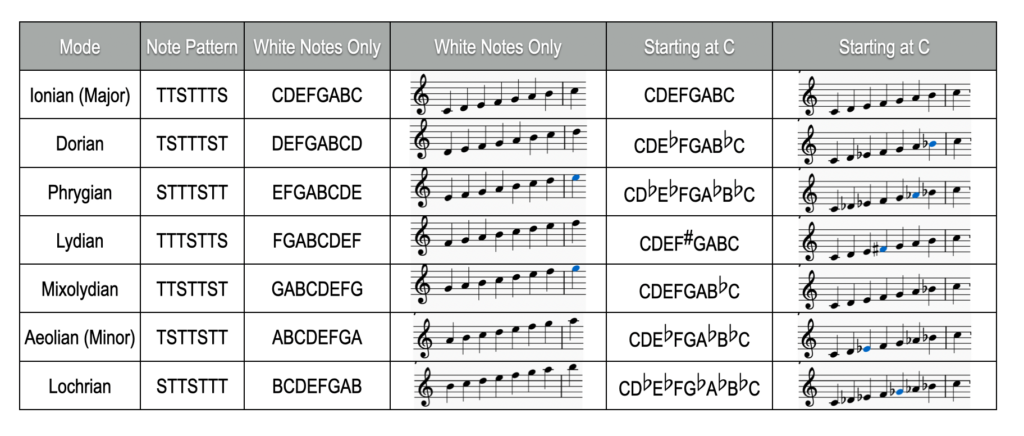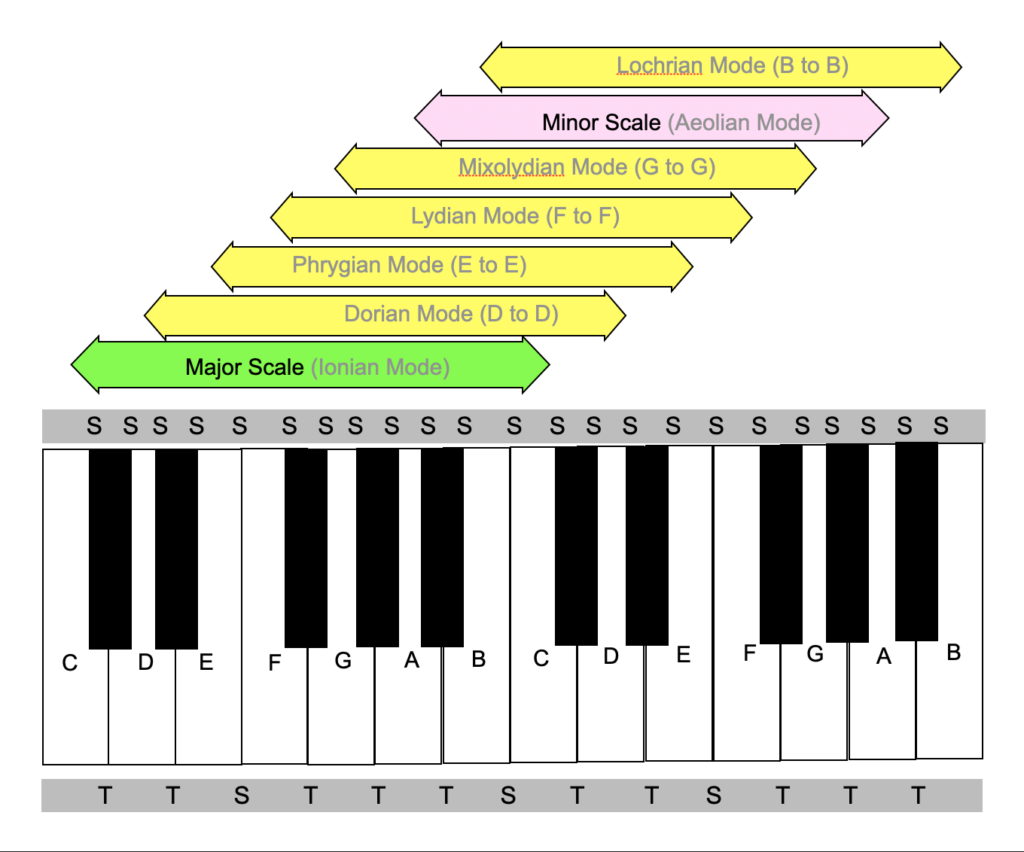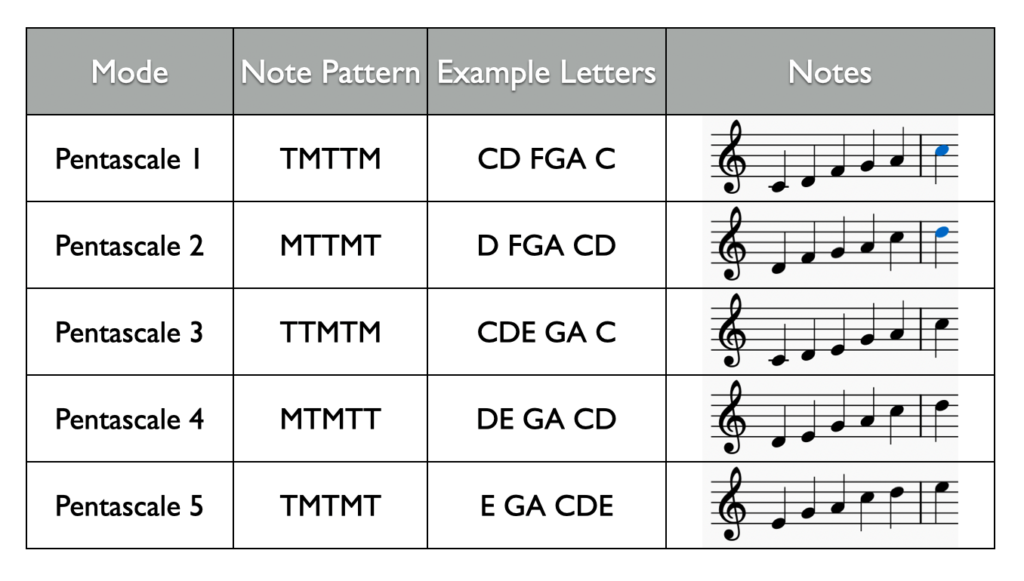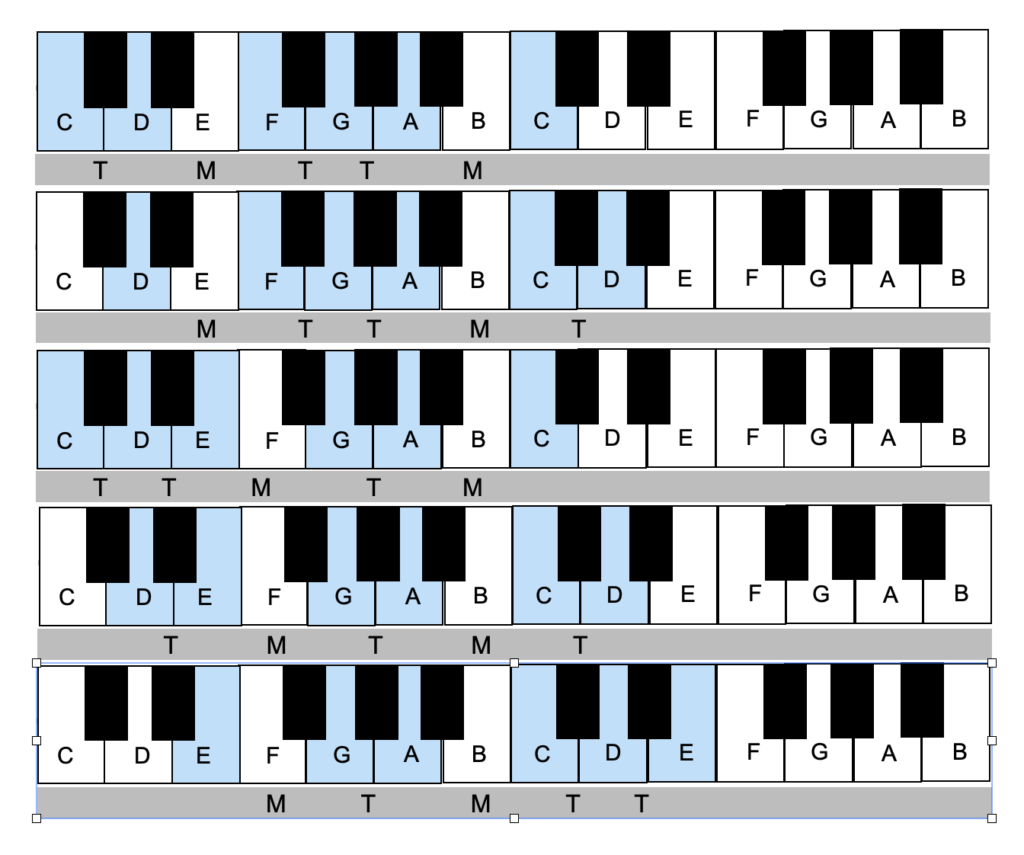Which Bell Set?
Learn to identify different scales…
Just because our bells were designed to ring as a diatonic major scale, does not mean we cannot experiment with other options.
The major scale is probably the most common scale in western style music, but that is something which has only really developed and become significantly prevalent in recent years. Look at medieval and renaissance music, folk music or church music… from any part of the UK… or world for that matter… and you will find lots of alternatives to the standard major or minor scale.
…and as we gradually find more and more diverse influences creeping into our society, we also find that alternative scales appear more and more in pop music too… so why shouldn’t the ringing community do likewise?
On this page, we explore the world of modes and scales to look at how we can alter the character of our ringing and create new and interesting changes.

Modes...
Mode were first documented in ancient Greek times, which gave them their names. This became the basis for church music and plain chant from the earliest times and of course it was natural that it would become a major element of the songs and tunes people sang for pleasure.
Over time, the Ionian (major) and a hybrid of the Aeolian mode (minor) became the mainstay of higher culture and classical music. With the advent of mass communications (radio, gramophone, etc.) a lot of the old traditions died off and the major and minor scales took over. Thanks to the work of folk song collectors such as Cecil Sharp, Gustav Holst and Ralph Vaughan Williams in the UK and many others working worldwide, a lot of this disappearing culture was written down or recorded and over the last century has gradually become of interest again in all genres of culture.
The basic modes all use the same notes as the standard major scale, so they fit perfectly with our diatonically tuned bells. The difference between a mode and the major scale is where it starts and finishes.
There are 7 differently named notes before we reach the first octave and start repeating notes with the same name. Depending on which note we start on, we will get a different sounding scale.
From a ringing point of view, these different modes will produce a different character and some of the more obscure (Lochrian in particular) would take some getting used to. However, because the scales still have 8 notes the language is similar, so our favourite compositions and methods will still throw up the expected changes… they just may have a different character to them… mostly less bright and perhaps more plaintive in different degrees.


Listen
Listen to the different modes… these examples all start on the same note, so you can clearly hear the difference in character of each… but remember the same effect can be obtained starting on any note… and as ringers, we would do this by selecting a different selection of ropes from normal.
Ionian/Major mode
Dorian Mode
Phygian mode
Lydian mode
Mixolydian mode
Aeolian mode
Lochrian Mode
Pentatonic Scales
Pentatonic scales have five notes to the octave. The simplest way to visualise a pentatonic scale is to only use the black notes on the keyboard… however, just like any other type of scale or mode, it could start on any note.
The pentatonic scale is made up from three tones (T) and two minor thirds (M)… however, the minor thirds cannot be consecutive.
As a result, there will be 5 different options for a pentatonic scale.
Our examples below are based on white notes only, but could be any combination of black and white and start on any note… it is the pattern which is important.
Interestingly, from a change ringing point of view, which of these possibilities you choose makes very little difference to the overall sound and character of these scales, so the potential for their use is enormous. However, specific changes will sound very different and the rules for composing to get ‘musical changes’ to appear will be completely different.The reultsi that Queens and tittums will probably not be as appealing, but equally the change we dislike will seem far less objectionable. It is a different musical language… and as different as English and Japanese!
‘In a musical world, it is equally difficult to pinpoint exactly which of these pentatonic scales is being used, because the rules of harmony and structure change when you move to this system! One of the most attractive things about the pentatonic world is that notes blend well… it is actually quite difficult to create real dissonance.


Listen
Listen to each of the pentatonic variant… you will hear that each is slightly different and yet very similar… if you struggle to note any significant different, that is fine… However, all will sound very different from the modes!
Penta 1
Penta 2
Penta 3
Penta 4
Penta 5
Pebworths different rings…
Using the Pebworth bells, we can create four different 8-bell sets in addition to the full ring of 10. This includes the standard back eight major scale we would normally choose, but also a Dorian mode set (2-9), a Phrygian mode set(1-8) and one pentatonic set (123 56 890).
And at Evesham Bell Tower…
Evesham is a 12 bell tower with an extra treble (bell 0) and a flat 6th,
This provides three extra 12 bell options…
- Dorian (0-11)
- Aeolian (0-11 +6♭)
- Mixolydian (1-12 +6♭).
There are also 8 alternative 10 bell rings.
- Ionian/Major (3-12)
- Dorian (2-11)
- Aeolian (2-11 + 6♭)
- Phrygian (1-10)
- Lydian (0-9)
- Mixolydian (3-10 +6♭).
- Pentatonic. (012 45 789 ET)
- Pentatonic. (01 345 78 TET).
All modes are possible at 8 bell and too numerous to list!
What about six-bell towers?
What can your tower do?
Why not look at options for modal and pentatonic ringing and maybe even trying it out. It will take a bit of getting used to, so don’t expect it to instantly be a hit. Remember, that with pentatonic rings, our normal call change preferences and the music you expect touches will not happen, but other changes might just stand out instead!
Which Bell Set games...
Listen to the clips and decide which mode or scale the bells are ringing.
In part 1, all the clips are just simple rounds which should make it a bit easier. In part 2, it is methods, so it will be harder, but the character of the ringing will still change.
- For the five bell clips you only need to choose between major, minor and pentatonic.
- For six-bell, Dorian, Phrygian and Lydian modes as well as major and pentatonic are possible.
- For eight-bell, we can remove Lydian.
- For pentatonic, we will not ask you to identify which of the 5 types it is…. that would probably be a bit mean!
Part 1 - Rounds
Well Done!
Think again...!
Have another listen, then try again. Remember, it will take time and practice to get good at anything!
Think again...!
Have another listen, then try again. Remember, it will take time and practice to get good at anything!
Well Done!
Think again...!
Have another listen, then try again. Remember, it will take time and practice to get good at anything!
Think again...!
Have another listen, then try again. Remember, it will take time and practice to get good at anything!
Think again...!
Have another listen, then try again. Remember, it will take time and practice to get good at anything!
Well Done!
Think again...!
Have another listen, then try again. Remember, it will take time and practice to get good at anything!
Think again...!
Have another listen, then try again. Remember, it will take time and practice to get good at anything!
Think again...!
Have another listen, then try again. Remember, it will take time and practice to get good at anything!
Think again...!
Have another listen, then try again. Remember, it will take time and practice to get good at anything!
Well Done!
Think again...!
Have another listen, then try again. Remember, it will take time and practice to get good at anything!
Think again...!
Have another listen, then try again. Remember, it will take time and practice to get good at anything!
Think again...!
Have another listen, then try again. Remember, it will take time and practice to get good at anything!
Think again...!
Have another listen, then try again. Remember, it will take time and practice to get good at anything!
Well Done!
Well Done!
Think again...!
Have another listen, then try again. Remember, it will take time and practice to get good at anything!
Think again...!
Have another listen, then try again. Remember, it will take time and practice to get good at anything!
Think again...!
Have another listen, then try again. Remember, it will take time and practice to get good at anything!
Think again...!
Have another listen, then try again. Remember, it will take time and practice to get good at anything!
Think again...!
Have another listen, then try again. Remember, it will take time and practice to get good at anything!
Think again...!
Have another listen, then try again. Remember, it will take time and practice to get good at anything!
Think again...!
Have another listen, then try again. Remember, it will take time and practice to get good at anything!
Well Done!
Well Done!
Think again...!
Have another listen, then try again. Remember, it will take time and practice to get good at anything!
Think again...!
Have another listen, then try again. Remember, it will take time and practice to get good at anything!
Well Done!
Think again...!
Have another listen, then try again. Remember, it will take time and practice to get good at anything!
Think again...!
Have another listen, then try again. Remember, it will take time and practice to get good at anything!
Think again...!
Have another listen, then try again. Remember, it will take time and practice to get good at anything!
Well Done!
Think again...!
Have another listen, then try again. Remember, it will take time and practice to get good at anything!
Think again...!
Have another listen, then try again. Remember, it will take time and practice to get good at anything!
Think again...!
Have another listen, then try again. Remember, it will take time and practice to get good at anything!
Well Done!
Part 2 - Methods
5-Bells
Grandsire Doubles
Think again...!
Have another listen, then try again. Remember, it will take time and practice to get good at anything!
Erin Minimus
Well Done!
Stedman Doubles
Think again...!
Have another listen, then try again. Remember, it will take time and practice to get good at anything!
Stedman Doubles
Well Done!
Stedman Doubles
Well Done!
Grandsire Doubles
Think again...!
Have another listen, then try again. Remember, it will take time and practice to get good at anything!
Stedman Doubles
Think again...!
Have another listen, then try again. Remember, it will take time and practice to get good at anything!
Erin Minimus
Think again...!
Have another listen, then try again. Remember, it will take time and practice to get good at anything!
Stedman Doubles
Think again...!
Have another listen, then try again. Remember, it will take time and practice to get good at anything!
6-Bells
Little Bob
Think again...!
Have another listen, then try again. Remember, it will take time and practice to get good at anything!
Well Done!
Think again...!
Have another listen, then try again. Remember, it will take time and practice to get good at anything!
Plain Bob Doubles
Think again...!
Have another listen, then try again. Remember, it will take time and practice to get good at anything!
Well Done!
Think again...!
Have another listen, then try again. Remember, it will take time and practice to get good at anything!
Cambridge
Think again...!
Have another listen, then try again. Remember, it will take time and practice to get good at anything!
Think again...!
Have another listen, then try again. Remember, it will take time and practice to get good at anything!
Think again...!
Have another listen, then try again. Remember, it will take time and practice to get good at anything!
Kent
Think again...!
Have another listen, then try again. Remember, it will take time and practice to get good at anything!
Think again...!
Have another listen, then try again. Remember, it will take time and practice to get good at anything!
Think again...!
Have another listen, then try again. Remember, it will take time and practice to get good at anything!
St Simon's Doubles
Think again...!
Have another listen, then try again. Remember, it will take time and practice to get good at anything!
Well Done!
Think again...!
Have another listen, then try again. Remember, it will take time and practice to get good at anything!
Cambridge
Think again...!
Have another listen, then try again. Remember, it will take time and practice to get good at anything!
Think again...!
Have another listen, then try again. Remember, it will take time and practice to get good at anything!
Well Done!
Plain Bob Doubles
Think again...!
Have another listen, then try again. Remember, it will take time and practice to get good at anything!
Well Done!
Think again...!
Have another listen, then try again. Remember, it will take time and practice to get good at anything!
Kent
Think again...!
Have another listen, then try again. Remember, it will take time and practice to get good at anything!
Well Done!
Think again...!
Have another listen, then try again. Remember, it will take time and practice to get good at anything!
S Simon's Doubles
Well Done!
Think again...!
Have another listen, then try again. Remember, it will take time and practice to get good at anything!
Think again...!
Have another listen, then try again. Remember, it will take time and practice to get good at anything!
8-Bells
Stedman
Think again...!
Have another listen, then try again. Remember, it will take time and practice to get good at anything!
Well Done!
Yorkshire
Think again...!
Have another listen, then try again. Remember, it will take time and practice to get good at anything!
Think again...!
Have another listen, then try again. Remember, it will take time and practice to get good at anything!
Little Bob
Think again...!
Have another listen, then try again. Remember, it will take time and practice to get good at anything!
Think again...!
Have another listen, then try again. Remember, it will take time and practice to get good at anything!
Yorkshire
Think again...!
Have another listen, then try again. Remember, it will take time and practice to get good at anything!
Well Done!
Plain Bob Triples
Well Done!
Think again...!
Have another listen, then try again. Remember, it will take time and practice to get good at anything!
Stedman
Think again...!
Have another listen, then try again. Remember, it will take time and practice to get good at anything!
Think again...!
Have another listen, then try again. Remember, it will take time and practice to get good at anything!
Little Bob
Think again...!
Have another listen, then try again. Remember, it will take time and practice to get good at anything!
Well Done!
Rev Canterbury Triples
Well Done!
Think again...!
Have another listen, then try again. Remember, it will take time and practice to get good at anything!
Plain Bob Triples
Think again...!
Have another listen, then try again. Remember, it will take time and practice to get good at anything!
Think again...!
Have another listen, then try again. Remember, it will take time and practice to get good at anything!
